Searching for King Arthur: Art, nature and legends in Brittany’s interior
France’s coasts in Brittany are – justifiably – extremely popular with tourists. Yet Brittany also boasts an interesting interior, replete with beautiful churches and castles, charming towns and landscapes and locations from Arthurian legend; nevertheless, most tourists never make it here.
On a two-week trip to Brittany, we chose to base ourselves in Brittany’s interior and take day trips within the interior and to the more popular coastal towns. We loved both, but considered it a real advantage to intersperse the extremely crowded coastlines with the tranquility of beautiful inland destinations.
Here are some of our favorite places in inland Brittany:
Huelgoat Forest
This stunning area of giant, moss-covered boulders, towering trees, brooks and waterfalls is a lovely place to go walking on well-marked paths leading into the forest. Climb down the steep descent to the Grotte du Diable (Devil’s cave). There are numerous signs pointing out the areas connected to the legend of King Arthur.
Le Faouët
The town itself, south of Carhaix, is known for its 16th century halles (covered market), right on the town’s central square. It is one of the few wooden structures of this type and period surviving to this day and it is still used as a marketplace. The town is best known for two nearby churches and both merit a visit.
The 16th century Chapel of Saint Barbara, outside of the town, is an architectural gem and is nestled on a hill, in a panoramic spot overlooking the Ellé River. Since we were there with our children and were joined by French friends with their young children in tow, the real highlight was the bell tower. Since we were the only people there, the kids had a great time ringing the big, heavy bell to their hearts’ content.
Just 2 km south of town is the recently restored 15th century Saint-Fiacre. The masterpiece here is the 1480 wooden screen, built to separate the altar from the congregation. The delicate 15th century screen carvings are beautiful and dramatic, depicting scenes from the Old and New Testaments in intricate detail. There are also whimsical depictions of the seven deadly sins.
The beautiful colours have been maintained, giving us an idea how church interiors must once have appeared and providing a better insight into the role of religious art in illustrating Bible teachings to medieval parishioners, many illiterate.
Kernascléden
About 15 km southeast of Le Faouët, in the small town of Kernascléden, is another 15th century church worthy of exploration. The weather-beaten exterior of grey stone has wonderful carved gargoyles.
The interior frescoes on one of the side-chapels has terrifyingly spectacular, though damaged, frescoes of the damned condemned to the fires of hell, complete with horrifying devils stoking the fires. We were all alone in the church to examine these eerie images, which must have done their part in keeping centuries of Kernascléden residents on their best behaviour.
Paimpont Forest
 The Forêt de Paimpont, Paimpont Forest, was once known as Brocéliande and is another place of Arthurian legend. The charming central village of Paimpont is right on a small lake. It’s a good place to stop and to visit the tourist office with walking maps and helpful advice on excursions.
The Forêt de Paimpont, Paimpont Forest, was once known as Brocéliande and is another place of Arthurian legend. The charming central village of Paimpont is right on a small lake. It’s a good place to stop and to visit the tourist office with walking maps and helpful advice on excursions.
There are some nice walks to be had around this pretty forest land. As fans of King Arthur stories, our sons were keen on seeing the gold-painted tree where the young and beautiful Vivian is said to have imprisoned the wizard Merlin.
Fougères
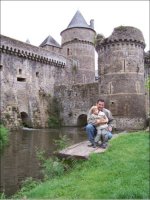 This town, 50 km northeast of Rennes, is ideal for castle lovers. Strangely, the castle is not perched on a defensive, high peak, but laid out below the town.
This town, 50 km northeast of Rennes, is ideal for castle lovers. Strangely, the castle is not perched on a defensive, high peak, but laid out below the town.
It was built in 1166, replacing a wooden fort on the same site which had been destroyed by English invaders. The castle has massive walls and a large moat still filled with water.
A visit allows you to walk the walls and climb the towers to enjoy the panorama. It’s very impressive and the area around the castle makes a nice place to stop for lunch while enjoying the view.
Other places of interest in Brittany’s interior are Pontivy, Josselin, Vitré and the city of Rennes. On your next trip to Brittany, enjoy what the region’s less-visited interior has to offer. You will be pleasantly surprised – and happy for a respite from the crowds.
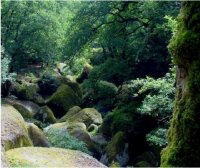
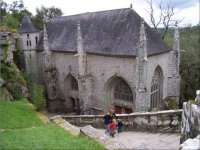
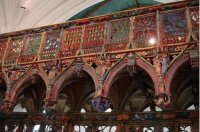
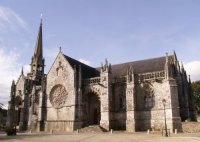
I love the interior of France, Burgundy especially. So much to discover, so many mysteries to unfold. My favourite place is Vézelay, a gorgeous Romanesque church and rolling hills and villages. Hope you had a good festive season!
Hi Catherine! I agree that France is gorgeous – and so much to explore. I like Burgundy, too, although I have not yet been to Vézelay. Will add it to my (shamefully extensive) to-see list. : )
I had no idea that Brittany held Arthurian sites of interest. I thought he was connected to Wales, not France? Sounds like a prefect selection of sites for history buffs and kids alike.
Right, Grace, but just the Channel between them, and lots of migration at the time to the continent from ‘Britania’. Brittany used to be Little Britain to distinguish it from Great Britain. Apparently the Welsh and Breton languages are also similar. Although I speak neither, so I’m not one to judge! As you can see, I learned a lot there, too. Even more excuses to travel…
Lovely pictures and interesting tales… I am daydreaming.